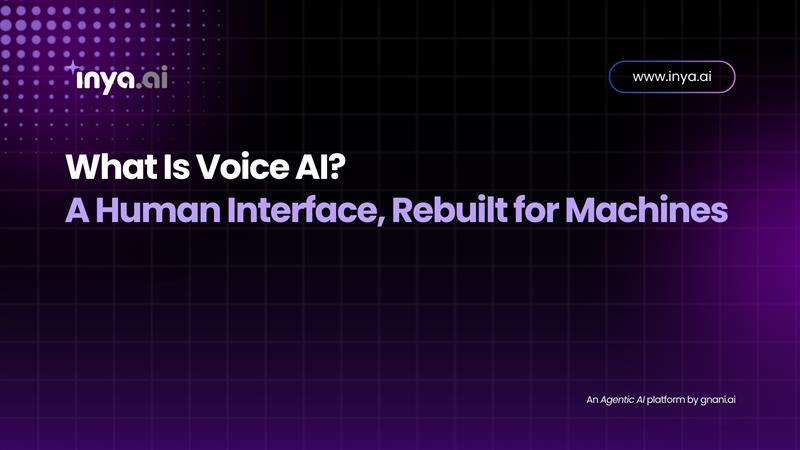There was a time when talking to a machine felt futuristic. Today, it’s expected. From barking commands at Alexa to navigating IVR hellholes, we’ve come a long way. But Voice AI — the kind that understands, acts, adapts, and sounds human — is a different beast entirely.
This blog dives into how Voice AI started, who built it, how it evolved, where it’s used, how it impacts revenue, and what’s coming next.
The Origins: From IVRs to Intelligent Speech
Voice interaction technology began in the 1950s with Bell Labs’ Audrey system, which could recognize digits spoken by a single voice. Progress was slow — in the 1980s and 90s, speech systems were limited to predefined commands or numeric menus.
Companies like IBM, Dragon Systems, AT&T, and Nuance began commercializing speech-to-text systems. The goal wasn’t AI — it was automation: pressing 1 without pressing 1.
These systems formed the foundation of IVR (Interactive Voice Response), used heavily in telecom and banking. But they weren’t conversational. They were structured, robotic, and brittle.
The First Wave of Voice Assistants
The 2000s changed that. Enter Siri (acquired by Apple in 2010), Google Voice, and later Alexa and Cortana.
These voice assistants moved beyond touch-tone replacement. They could:
- Understand questions
- Respond conversationally
- Offer information (weather, directions, reminders)
But they were still command-based. Their capabilities were narrow, and they didn’t understand context, memory, or intent deeply.
The LLM Era: Voice Gets Smarter
The 2020s saw the rise of LLMs (Large Language Models) and SLMs (Small Language Models). Suddenly, machines could:
- Parse unstructured voice inputs
- Understand multilingual code-mixed speech
- Carry forward context across turns
- Personalize conversations based on history
- Trigger backend workflows in real time
Platforms like Inya.ai by Gnani took this further — combining real-time multilingual ASR, API execution, and memory into enterprise-grade voice bots.
So What Exactly Is Voice AI?
Voice AI is not just ASR (speech-to-text). It’s a stack of technologies that enables machines to have human-like conversations over voice.
It includes:
- ASR (Automatic Speech Recognition) – Converts voice to text
- NLU (Natural Language Understanding) – Understands meaning and intent
- Dialog Management – Chooses what to say/do next
- TTS (Text-to-Speech) – Speaks back to the user
- LLM/SLM layer – Adds reasoning, personality, memory
- API orchestration – Executes actions, not just replies
Together, this makes Voice AI a fully interactive human-machine interface.
Who’s Using Voice AI — And Why?
Voice AI isn’t just a tech demo anymore. It’s running millions of conversations daily across industries:
Banking & Finance
- EMI reminders, collections, fraud alerts
- Loan pre-approvals, onboarding
- Voice-based KYC
Telecom
- Plan renewals, troubleshooting
- Barring/unbarring flows
- Automated DND registration
Healthcare
- Appointment scheduling
- Insurance verification
- Post-consult follow-ups
Retail & Ecommerce
- COD confirmation
- Delivery updates
- Feedback collection
Travel & Airlines
- Booking confirmation
- Rescheduling
- Multilingual support for ticketing
Education
- Exam reminders
- Admissions support
- Language tutoring bots
How Does It Help? Revenue, Retention & Reach
Voice AI drives direct business impact:
- ✅ Faster resolution = Lower AHT (Average Handling Time)
- ✅ 24/7 service = No dependency on human hours
- ✅ Multilingual reach = Tap into new segments (tier 2–4 cities)
- ✅ Higher conversions = Voice-based upsell, lead re-engagement
- ✅ Better recovery = Automated reminders + real-time payment triggers
- ✅ Lower cost = Replace L1 agents, deflect FAQs, reduce escalations
One well-tuned voice AI agent can handle thousands of concurrent calls, in multiple languages, across regions — at a fraction of human cost.
Voice AI vs Chatbots vs IVRs
| Feature | IVR | Chatbot | Voice AI |
| Input Type | Keypad | Text | Speech |
| Natural Language | ❌ | ✅ | ✅✅✅ |
| Multilingual Support | ❌ | ✅ | ✅✅✅ |
| Real-Time Actions | ❌ | Partial | ✅ |
| Personalization | ❌ | Medium | High |
| Context Handling | None | Limited | Full |
| Human-Likeness | Low | Medium | High |
Challenges: Why Few Do It Right
Building real Voice AI — not just scripted IVR replacements — is hard.
- ASR has to be real-time, low-latency, and tuned per language/region
- NLP must understand accents, slang, and code-switching
- Backend orchestration must be secure, fast, and reliable
- Interruptions (barge-in) must be handled without breaking logic
- Memory must persist across turns and sessions
This is why most platforms break when you go off-script.
Gnani.ai’s Inya platform is one of the few that supports:
- 40+ languages
- Real-time barge-in
- API-based action layer
- Memory-aware voice agents
- Enterprise-scale concurrency (30M+ calls/day)
The Future of Voice AI
Voice is becoming the new UX. What typing was to 2010, talking is to 2025+.
Expect:
- Voice-first apps (no UI needed)
- AI sales agents doing full-funnel follow-ups
- Emotion-aware conversations
- Voice+video agents with human avatars
- Voice replacing traditional call centers entirely
Voice AI is no longer an assistant. It’s a revenue channel, a support desk, and a digital teammate — all in one.
Final Thoughts
Voice AI started as a novelty. Today, it’s table stakes. If your business still depends on DTMF, chat-only bots, or ticket-based support — you’re already behind.
The future speaks.
And with Voice AI, your business can finally listen — and talk — at scale.


